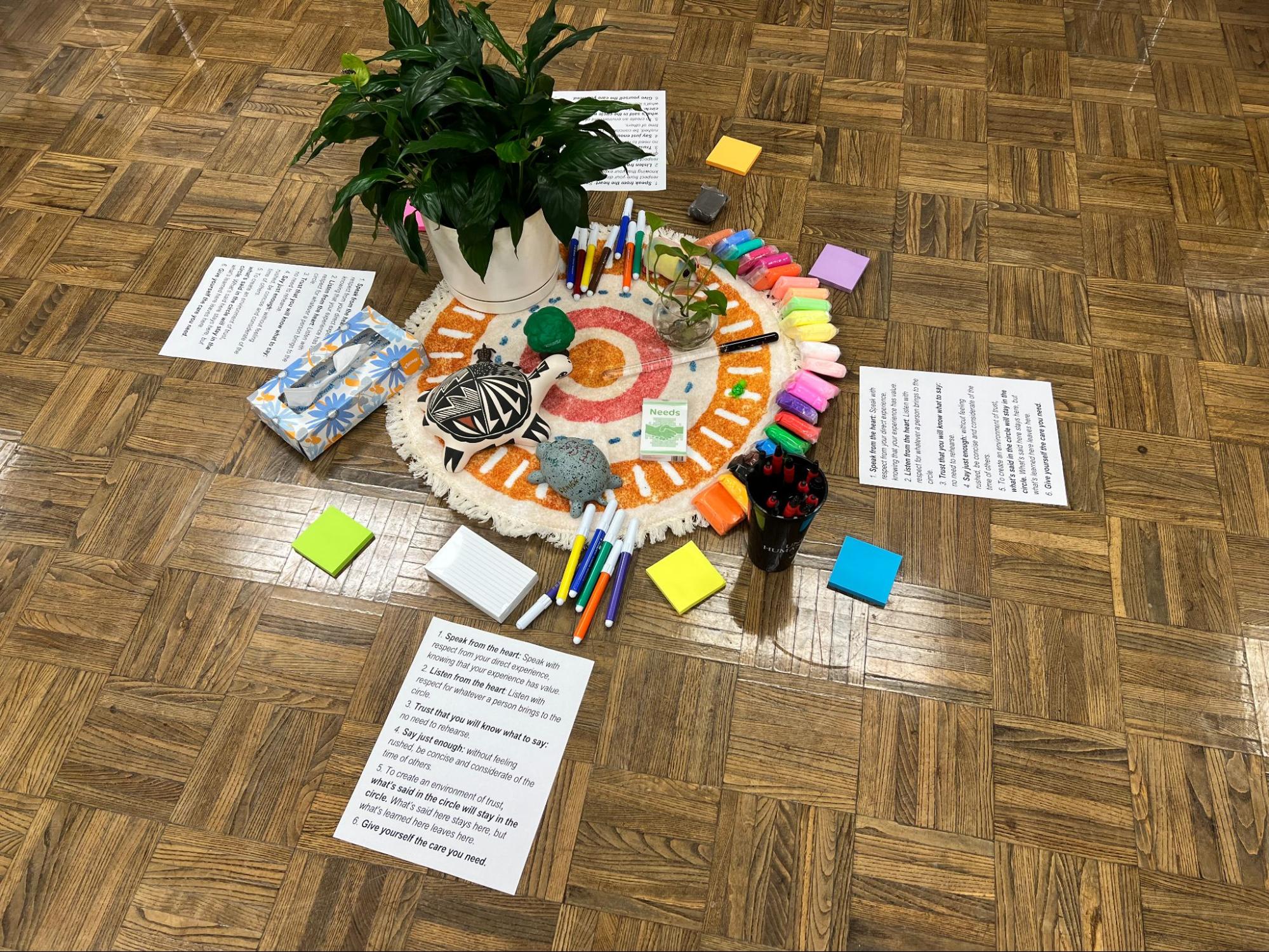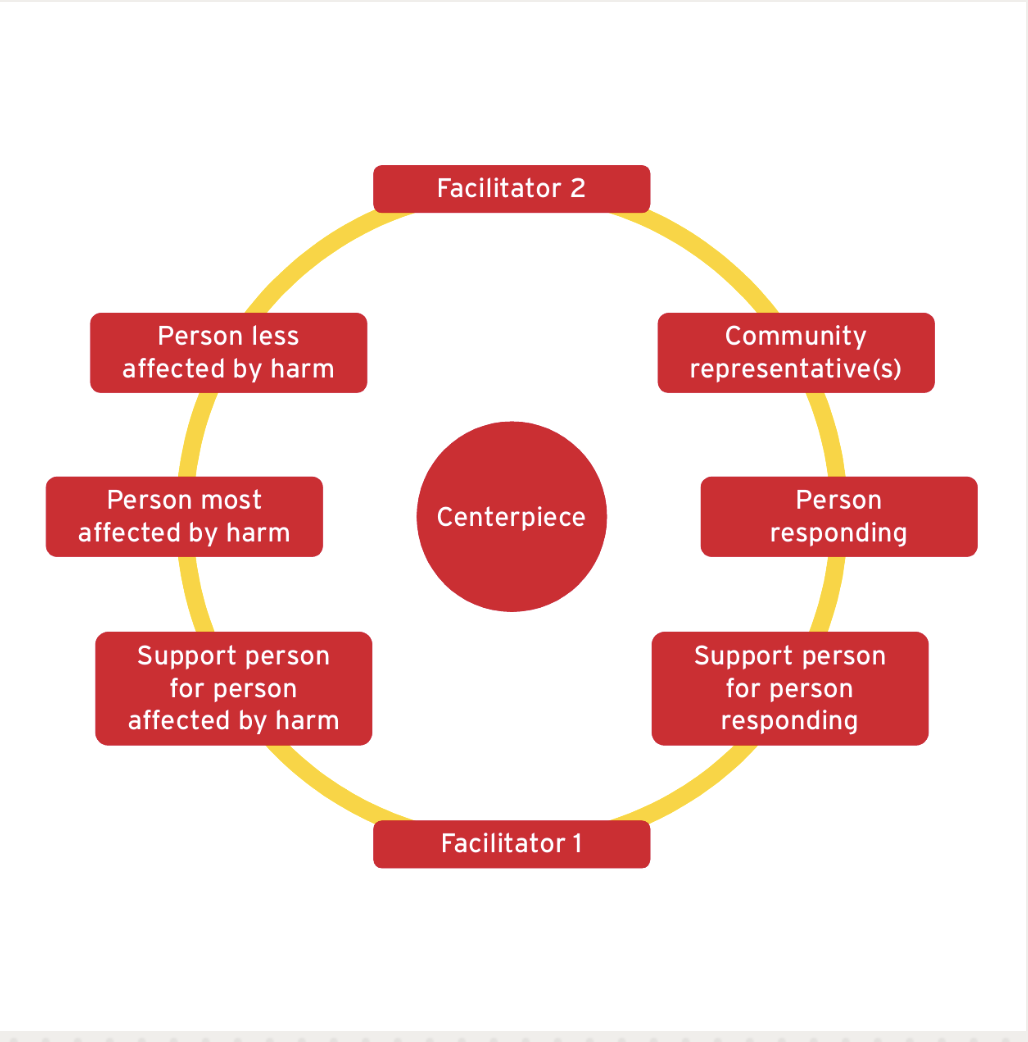Restorative Justice Alternative Resolution Process

The purpose of restorative justice (RJ) as an alternative resolution process to the formal conduct process is to apply restorative philosophy to help our community understand how they impact themselves and those around them, and to build a stronger and more caring community.
Research shows that this practice reduces recidivism (Newton, 2016), increases participants’ satisfaction in the process and trust among those involved (Hwang, 2020), and even increases graduation rates (Gregory & Evans, 2020).
What is Restorative Justice?
Rooted in Indigenous and spiritual traditions from across the globe, restorative justice is a community approach to resolving conflict; emphasizing our interconnectedness and nurturing relationships through respect, support, and healing. RJ depends on those involved to collaboratively repair harm, addressing unmet needs and moving towards healing.
| Indigenous/Spiritual Community | Restorative Tradition | Ancestral Lands | Also Known As |
|---|---|---|---|
| Maori | Restorative Justice Conferences | Aotearoa | New Zealand |
| Ojibwe | Healing Ceremonies | Bawating Nayaano-nibiimaang Gichigamiin (Literal translation: The 5 Freshwater Seas) | Canada |
| Cree | Healing Circles | "Eeyou Istchee," which means "The Land of the People" | Canada |
| Organized Village of Kake (Tlingít) | Circle Peacemaking Program (Additional Source) | Lingít Aaní ( Map Reference) | Alaska |
| Abenaki (*Abenaki means “People of the Dawnland” - “waban,” meaning “east,” and “aki,” meaning “land.”) | Healing Circles | Ndakinna (Homeland) | Northeast U.S |
| Navajo | Peacemaking (hozhooji naat’aanii, 'people talking together to re-form relationships with each other and the universe.’) | Dinétah meaning “among the people” Also Diné Bikéyah | Southwest U.S |
| Pokagon Band of Potawatomi Indians AKA Neshnabé (autonym) AKA Bodéwadmi (Keepers of the Fire (name used by other indigenous people) | Peacemaking Circles Native Justice Model: Unleashing the Power of the Circle |
Mzhigé'nak Note: This word translates to Michigan generally, though this group is specifically from Southwest Michigan |
Straits of Mackinac (Great Lakes Region)
Southwest Michigan |
| Native Hawaiian (Kānaka Maoli (autonym)) | Ho'oponopono (To set right) | Hawai’i | Mokupuni Hawai’i |
| Louden Tribe | Circle Sentencing | Galena Village | Galena, Alaska |
| Mennonite | Peacebuilding and Reconciliation |
Note: This chart is not an exhaustive list, but rather, a few examples to illustrate the rich variety of traditions across Indigenous communities.
Restorative justice is based on restorative philosophy, the simplified notion of “what impacts you, also impacts me.” Restorative practices foster community building, repair harm, and rebuild trust, to create a healing and productive experience for everyone involved.

What we aim to do:
- Center the needs of those harmed
- Repair the harm caused
- Rebuild trust and support the growth of those who caused harm
- Honor and invest in our UMD community's healing and thriving
After years of relationship building, research, training, and practice, the RJ Committee, composed of UMD staff, students, faculty, and alumni, succeeded in getting the Restorative Justice Alternative Resolution Process included in the Code of Student Conduct as an option for individuals to be accountable for their actions and repair the harm that they have caused.
If a student is referred to the Office of Student Conduct, or the Office of Rights and Responsibilities, they may be able to opt into the Restorative Justice Alternative Resolution Process (RJARP), if their case is eligible (e.g., responding party must, at minimum, acknowledge they caused harm). Section G of the Code of Student Conduct notes,
The Office of Student Conduct may develop Alternative Resolution options, which may include options such as restorative justice practices, mediation, or an informal resolution agreement. At the discretion of the Office of Student Conduct, the Responding Party may be permitted to have their case resolved in an Alternative Resolution option without participating in a formal resolution proceeding through a Disciplinary Conference, Disciplinary Conference Board, or Student Conduct Board.
If an Alternative Resolution option is utilized and resolves the matter, the Responding Party waives the right to appeal the outcome, including any agreement, if applicable.
How is RJ different from the formal process?
| Traditional Conduct Process | The Restorative Justice Alternative Resolution Process (RJARP) | |
|---|---|---|
| Flow of Process Flow of Process | Traditional Conduct Process Referrals are made to the Office of Rights and Responsibilities and the Office of Student Conduct then the conduct process, alleged violations, and/or potential sanctions are discussed with the student. | RJARP The restorative process will occur if both parties agree that harm was caused and want to move forward with this process. They will participate in pre-circle meetings before the final circle meeting, where they will decide together the best course of action to repair the harm caused. |
| Guiding Questions Guiding Questions | Traditional Conduct Process What code or rule was potentially broken? Was the code or rule broken? Who broke it? What sanction is appropriate based on the severity of the situation? | RJARP Who was harmed? How can the harm be repaired? Whose responsibility is it to repair the harm? How can the person that caused the harm regain the community’s trust and eventually become a meaningful part of the community? |
| Eligibility Eligibility | Traditional Conduct Process All students are afforded due process. | RJARP The case must be deemed eligible for RJARP. At minimum, the Person Responding (ie. the Responding Party) must acknowledge that they have caused harm and want to make it right. Both the responding person and the person affected by harm must agree to participate. |
| Who’s Involved Who’s Involved | Traditional Conduct Process Responding party, witnesses, case manager, student legal aid or attorney (optional) | RJARP Person Responding, Person Affected by Harm, Support Person(s), Community Representative, trained Restorative Facilitators |
| Outcome Outcome | Traditional Conduct Process The assigned case manager or hearing board will make a determination of responsibility based on the findings of fact, as well as the sanctions. If found responsible, the student will have a disciplinary record for at least three years. | RJARP Those involved in the circle conference, excluding the two facilitators, will decide together what the Resolution Plan will include for the Person Responding to complete. The goal of the Resolution Plan is to hold the person accountable by having them repair the harm they caused and prevent future harm. If the resolution plan is completed, the Person Responding will not have a disciplinary record with the university. |
Process & Steps
When a potential policy violation occurs, students meet with the Office of Student Conduct or the Office of Rights and Responsibilities for a Preliminary Interview. If eligible, they can opt into the RJARP. The Person Affected by Harm must also agree to participate for the process to continue.
RJ facilitators then hold separate pre-circle conference meetings with the Person Responding, the Person Affected by Barm, and their Support People. These meetings prepare everyone for the conference circle, offering support, resources, and reflection.
In the conference circle, the Person Responding, the Person Affected by Harm, and at least one circle facilitator will identify the harm done, discuss the impact, and collaboratively create a plan for the Person Responding to repair the harm. Once the plan is completed, the case is closed without any disciplinary record. If no plan can be agreed upon, the case returns to the formal conduct process.
Glossary
The person whose actions or words have caused harm to others. This person will respond to the harm they caused and work to make it right.
The person who has been negatively impacted by the actions of the person responding.
Person who supports either the Person Responding or Person Affected by Harm that provides emotional support. In the circle conference, this person also shares how the situation impacted them and what they think should happen moving forward in order to make things right.
Person in the circle who is a part of the community that the incident impacted. They might also be personally impacted by the situation.
A meeting or meetings with the RJ Facilitators to prepare for a meaningful circle conference. The goal is to allow parties to know what to expect, provide support, and for the Person Responding, allow for learning and growth before the Circle Conference.
When all parties gather to name what harm happened, how they were impacted, and decide together how to move forward.

- What happened?
- What were you thinking at the time?
- What have you thought about since?
- Who has been affected by what you have done?
- In what way?
- What do you think you need to do to make things right?
- What did you think when you realized what had happened?
- What impact has the incident had on you and others?
- What has been the hardest thing for you?
- What do you think needs to happen to make things right?
Outcomes of the RJARP decided by all circle conference participants to be completed by the Person Responding. The goal of the resolution plan is to repair the harm caused by the Person Responding and rebuild the community’s trust in them.
References
Gregory, A., & Evans, K. R. (2020). The starts and stumbles of restorative justice in education: Where do we go from here? National Education Policy Center.
Hwang, A. (2020). Restorative Justice: A Better Alternative for Reducing Recidivism? The Sociological Imagination: Undergraduate Journal, 6(1).
Newton, D. (2016). Restorative justice and youthful offenders. LEB https://leb.fbi.gov/articles/featured-articles/restorative-justice-and-youthful-offenders
